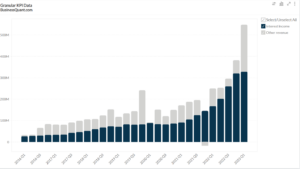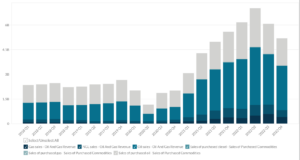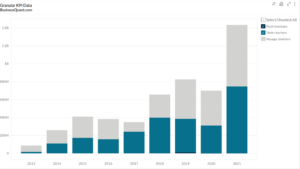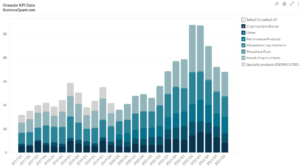
Alcoa Corp’s Revenue by Product Division (2017-2023)
Exclusive Data
You need the Pro Plan to access KPI data
- Full access to the platform
- KPI data & segment financials on US stocks
- Financial data on thousands of stocks
- Download data in xlsx and csv formats
Pro Plan
$49 per month*
60% discount ends in:
.
About
More information
Subscribe to Pro or Enterprise plans to unlock this feature.
Contact the Analyst
Subscribe to Pro or Enterprise plans to unlock this feature.
Become a smarter investor today.
Access KPIs & Segment Financials on US stocks
This statistic highlights Alcoa Corp’s Revenue by Product Division, split across Alumina, Bauxite, Energy, Flat-rolled aluminum and Primary aluminum, reported on a quarterly basis from 2017 onwards.
Alcoa Corp’s Revenue by Product Division
This table highlights Alcoa Corp’s revenue by product division:
| Revenue by product division | Q3 2020 | Q2 2021 | Q3 2021 | Contribution in Q3 2021 |
| Primary aluminum | 1311.00 | 2112.00 | 2255.00 | 72.53% |
| Alumina | 697.00 | 684.00 | 752.00 | 24.19% |
| Energy | 26.00 | 49.00 | 117.00 | 4% |
| Bauxite | 50.00 | 34.00 | 52.00 | 1.7% |
| Flat-rolled aluminum | 284.00 | 0.00 | 0.00 | 0.0% |
| Other | -3.00 | -46.00 | -67.00 | -2.2% |
| Total | 2365.00 | 2833.00 | 3109.00 | 100.00% |
(all figures in millions, except percentages)
The following bifurcation depicts segment-wise information, considering the process involved to get a better understanding of the products and their workings:
Bauxite
This segment involves the company’s global bauxite mining operations. It acts as a primary raw material in the making of alumina and also contains various aluminum hydroxide minerals, of which the most crucial ones are gibbsite and boehmite.
A major part of the bauxite is processed into alumina making by the company and the rest is sold to third parties. The customer base associated with third parties lies in Asia specifically in China. Bauxite is obtained by the company from its own resources and from Alcoa World Alumina and Chemicals (“AWAC”), in accordance with both long and short-term contracts and mining leases.
Alumina
This segment, in the Alcoa Corp’s Revenue by Product Division statistic, comprises the company’s global refining system which processes bauxite into alumina. Alumina is sold worldwide through fixed-price spot sales and contracts, which is derived from two pricing components namely, the American Petroleum Institute (“API”) price basis and negotiated adjustment basis.
The pricing component fixes any price keeping into account various factors such as customer location, freight, quality, and market conditions. The average API of the company showed an upward trend marking an increase from 5% in Q3 2020 to 9% in Q3 2021. The major customer of smelter grade alumina is the company’s own aluminum smelters, while a minor part is sold to third-party customers who convert alumina into industrial chemical products.
Aluminum
Aluminum as an element is abundantly present on the earth’s crust, but converting it to the metal form requires a multi-step process. It is produced by refining alumina oxide from bauxite resulting in alumina, which is further smelted into aluminum that could be cast or rolled into various forms and shapes. This segment comprises the company’s (I) smelting and casting house business, (II) a portfolio of energy production business, and (III) rolling business.
I Primary Aluminum (Smelting and Casting house system) – Alumina is passed through the smelting operations, which produces primary aluminum in molten form. After that, through casting operations, it is converted into common alloy ingot products such as t-bar, sow, standard ingot; or value-add ingot products such as billet, rod, foundry, and slab. Primary aluminum contracts differ widely in duration, ranging from spot purchases to multi-year supply contracts. Pricing for the aluminum is fixed by keeping in view the following factors:
- The issued price by London Metal Exchange (“LME”) for commodity-grade P1020 aluminum,
- The issued regional premium applicable to the delivery location
- A negotiated product premium that acknowledges aspects such as alloy and shape.
II Energy – The energy assets supply power to external as well as internal customers. External customer base lies majorly in Brazil and to a lesser extent in the United States, while internal customers are the company’s Aluminum segment (Canada) smelter, Alumina segment (Brazilian refineries), and Warrick (Indiana) smelter and rolling mill.
Energy constitutes approximately 21% and 26% of the Company’s total alumina refining and primary aluminum production costs respectively. Contracts made under this category, range from short-term (day-ahead/real-time) or years in duration. Pricing of the energy assets is fixed after acknowledging the factors such as LME or other underlying fuel source index, cost-based, or prevailing regional market prices.
III Flat-rolled Aluminum (Rolling operations) – Alcoa’s rolled product business solely consists of the company’s Warrick Rolling Mill, which is an integrated aluminum manufacturing site situated in Indiana, United States. It produces aluminum sheets, which have the capability of participating in various market segments, including food can sheets, beverage can sheets, lithographic sheets, bottle stock, closure sheets, and industrial products. In 2020, this category sold 305,900 metric tons of Rigid Container Sheet (“RCS”) and industrial products to customers in North America.
On November 30, 2020, the Company entered into an agreement to sell the Warrick Rolling Mill, primarily for the production of aluminum cans at a total consideration of approximately $670, to Kaiser Aluminum Corporation (Kaiser).
Other
The other sub-classification, in the Alcoa Corp’s Revenue by Product Division statistic, includes acknowledged profits and losses related to embedded derivative instruments specified as cash flow hedges of forwarding sales of aluminum.
About the Company
Alcoa stands for “Aluminum Company of America”, and as the name suggests it is a leading bauxite, alumina, and aluminum products making company. It is the sixth-largest aluminum producer globally. The corporate headquarter of the company is located in Pittsburgh, Pennsylvania while its key market region lies in North America, South America, Europe, the Middle East, Australia, and China. The common stock of the company is traded on New York Stock Exchange (NYSE) under the ticker symbol “AA”.
Did you like Alcoa Corp’s Revenue by Product Division statistic?
Access more such KPI data points and segment financials on thousands of US stocks, with Business Quant.
You can get started here.
More data on US Stocks

Our Plans
Always know what you’ll pay. No hidden costs or surprises.
- Annual
- Monthly
60% discount till April 30
Pro
For serious investing
-
Company KPI data Access segment financials, non-GAAP metrics and KPI data from presentations and filings. Examples include financials by segment / region / product category, AT&T's broadband subscriber trends, Tesla's deliveries by model and lots more.
-
Stock research tools Features include : stock screener, stock comparison, industry financials, stock warnings, advanced charting tools, timeseries tables, scatter charts, financial statements, stock reports, SEC filings, stock ratings, institutional and insider ownership data. There are 200+ financial items and ratios on thousands of US stocks.
-
Industry data & tools Access premium operating data on 40+ industries. Examples include market share, smartphone shipments by vendor, subscribers by wireless carrier, historical gold production. There are 20,000+ such statistics.
Enterprise
For tailored workflows
-
All of Pro plan Get unfettered access to all our dashboards and dossiers.
-
Custom built features Get tailored dashboards built specially for you , based on your set of requirements, to simplify your research workflow.
-
Admin billing Back-end documentation support and multi-seat licensing.
* Billed annually, local taxes extra.
60% discount on Annual plan
Pro
For serious investing
-
Company KPI data Access segment financials, non-GAAP metrics and KPI data from presentations and filings. Examples include financials by segment / region / product category, AT&T's broadband subscriber trends, Tesla's deliveries by model and lots more.
-
Stock research tools Features include : stock screener, stock comparison, industry financials, stock warnings, advanced charting tools, timeseries tables, scatter charts, financial statements, stock reports, SEC filings, stock ratings, institutional and insider ownership data. There are 200+ financial items and ratios on thousands of US stocks.
-
Industry data & tools Access premium operating data on 40+ industries. Examples include market share, smartphone shipments by vendor, subscribers by wireless carrier, historical gold production. There are 20,000+ such statistics.
Enterprise
For tailored workflows
-
All of Pro plan Get unfettered access to all our features.
-
Custom built features Get tailored dashboards built specially for you , based on your set of requirements, to simplify your research workflow.
-
Admin billing Back-end documentation support and multi-seat licensing.
* Local taxes extra.






